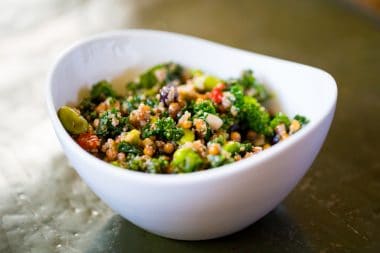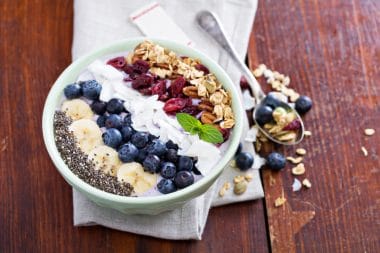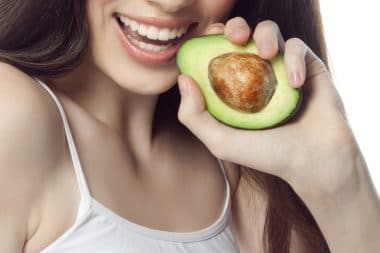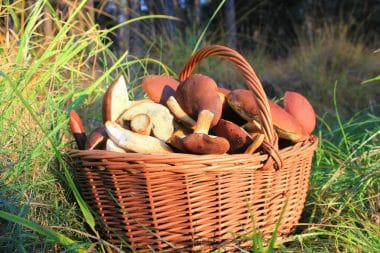How do you know you’ve bought imitation vanilla extract? Well simple really, the flavor and aroma are not extraordinary. Pure vanilla extract delights with an intense aromatic, floral aroma and a woody, smoky flavour. The liquid is a dark brown, deep chocolate colour which is derived from the robust extraction process.
Pure vanilla extract also comes with a higher price tag and the question most people ask is, “is there really a difference between pure vanilla extract and the imitation brands and is pure vanilla extract worth it”.
To answer this question, let’s delve into the differences between the different types of vanilla extract available and where one or the other is a better choice.
4 Types of Vanilla Extract
You get pure vanilla extract, imitation vanilla extract, vanilla flavour and then a combo of pure and imitation extract. Basically, vanilla extract is grouped into pure, imitation and flavoured.
To make your choice, you need to have a better understanding of the difference between the types of vanilla extract in order to interpret vanilla product labels.
Pure Vanilla Extract
In the United States, the Food and Drug Administrator (FDA) only allows vanilla extract to be labeled as Pure if it contains:
- 35% ethyl alcohol
- no less than 13.35 ounces (378 grams) of vanilla beans per gallon
- remaining liquid is distilled water
Some manufacturers add one or more ingredient to sweeten the flavor and get away with it because they are not listed on the Standard of Identity for pure vanilla extract. The added ingredients are usually sugar or corn syrup as well as caramel food dye to darken the liquid.
If you spot these added ingredients on the label, you know the brand is not 100% FDA-classified Pure.
With pure vanilla extract, there is some leeway with the alcohol used to extract the flavor. Traditionally, ethyl alcohol is used in pure vanilla extract. It’s derived from the fermentation or chemical breakdown of sugars by yeast, and produced by milling grains and then fermenting them with yeast.
Grain alcohol is the most commonly-used alcohol in pure vanilla extract but some extract manufacturers use sugarcane alcohol. The latter is typically used to mask the bitter notes of alcohol and create a sweeter taste. If you are gluten intolerant, pure vanilla extract made with sugarcane alcohol is a better choice.
Health Benefits of Pure Vanilla Extract
Vanilla contains anti-oxidant, anti-inflammatory and anti-depressant properties. Only the purist FDA-approved vanilla extract can offer you the essential health benefits of vanilla. Add pure vanilla extract to milkshakes and smoothies as well as skincare lotions to benefit from its healing properties.
Imitation Vanilla Extract
Imitation vanilla extract contains synthetic vanillin which is made in a laboratory. Imitation vanilla that is 100% synthetic vanillin is a clear colour. To create the dark, chocolate-brown colour to mimic pure vanilla extract, manufactures dye the solution with a caramel food coloring.
Imitation vanilla extract contains 2% alcohol which is used only as a preservative and to stabilise the liquid. It therefore falls well short of the FDA Standards of Identity as a pure vanilla extract.
The synthetic vanilla extract obviously contains chemicals which give it a bitter aftertaste. To mask it, manufacturers add sugar to the product. Some ingredients used in imitation vanilla are considered carcinogenic in the United States. As there are no strict label laws for imitation vanilla extract, manufacturers producing inferior brands tend to get away with what they put in their products.
Imitation vanilla extract is less expensive than pure vanilla extract because it’s made in a factory and bypasses the complicated and labor-intensive process of harvesting, drying, curing and extracting required to produce pure vanilla extract. However, for some purposes, the trade-off between price and purity is justified.
You can liken pure and imitation extract to eating an expensive chocolate bar like Lindt or Ferrero Rocher to a cheap chocolate bar. The latter uses synthetic cocoa and never matches the rich, decadent taste of pure chocolate. All the same, there’s a time when only Lindt chocolate will do and a time when it’s okay to chomp a cheaper chocolate.
Did you know?
A common source of synthetic vanillin is lignin which is a polymeric byproduct of the wood pulping industry. The processing of conifers, particularly spruce trees, into wood pulp for the paper industry results in significant lignin byproduct.
Conversion of lignin to vanillin not only harnesses this waste product, but also yields small amounts of acetovanillone which gives the resulting vanillin a fuller flavor more reminiscent to that of natural vanilla. This richer flavor coupled with the ready availability of lignin made this the preferred route to synthetic vanillin in the 20th century.
However, modern refinements in wood pulping have resulted in less lignin waste, driving up the cost of lignin-derived synthetic vanillin. Consequently, the cheaper route of converting synthetic guaiacol is now the preferred method for manufacturing synthetic vanillin.
Source: Vanilla regulations
Health Benefits of Imitation Vanilla Extract
Imitation vanilla extract is made using synthetic vanillin and contains chemicals that may be carcinogenic. You can’t rely on imitation vanilla extract to boost your vitamin and mineral intake if you’re using it in smoothies or skincare lotions for its health benefits.
Vanilla Flavor
Vanilla flavor is manufactured without alcohol. It does contain the required amount of vanilla beans per gallon, as specified by the FDA.
Instead of alcohol, vanilla flavor contains propylene glycol which is used as a common carrier to produce flavour and aroma in products. Vanilla flavor is suitable for people who don’t want to use a brand with alcohol in it for religious or personal reasons.
Propylene glycol is a chemical substance that is used as a food additive or ingredient in many processed foods, cosmetics and hygiene products. According to the FDA and European food authorities, it is generally safe to use in foods.
However, propylene glycol is not without its controversy. Considering the fact that it is also an ingredient added to anti-freeze, there is some concern over its possible toxic effect on humans. In fact, many people are allergic to the synthetic compound, particularly children with severe food allergies. This should obviously be a concern for commercial bakers and food manufacturers.
The reason why this type of food additive is called vanilla flavor and not vanilla extract is because it does not meet the Standard of Identity for extract, where the product must contain alcohol.
Natural Vanilla Extract
Natural vanilla extract is a market compromise between premium-priced pure vanilla extract and the cheaper alternatives. This type of vanilla extract contains a blend of pure vanilla extract and natural flavors derived from plants other than vanilla.
Natural vanilla extract comes closer than any of the synthetically-produced products in matching the robust, decadent flavour and aroma of pure vanilla extract. It’s produced worldwide to address supply and demand for vanilla extract, where the more expensive pure product is out of reach of your home baker and cook.
Pure, Imitation or a Combo of Both?
Naturally, choosing between pure and imitation vanilla extract or settling on a compromise between the two comes down to what you’re prepared to trade-off between purity and price. As always, it comes down to the simple fact that you get what you pay for.
Hopefully, this article clarifies the difference between the types of vanilla extracts on the market and helps you make a more informed choice. It’s important to understand what’s on the labels of these products so you can choose the best vanilla extract within your budget.








Reply